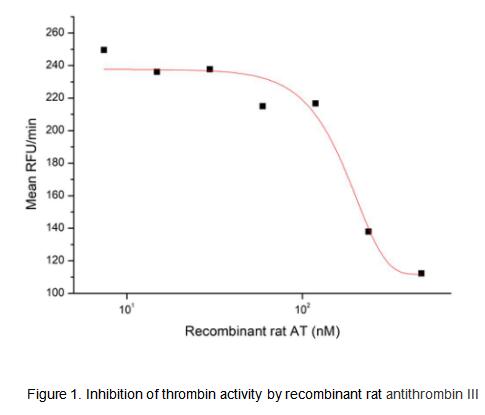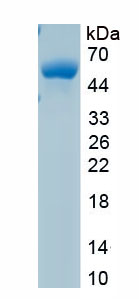Active Antithrombin (AT)
AT3; ATIII; SERPINC1; Anti-Thrombin Antibodies; Serpin Peptidase Inhibitor Clade C Member 1; Coding Sequence Signal Peptide Antithrombin Part 1
- Product No.APC313Ra02
- Organism SpeciesRattus norvegicus (Rat) Same name, Different species.
- Buffer FormulationPBS, pH7.4, containing 0.01% SKL, 5% Trehalose.
- Traits Freeze-dried powder
- Purity> 90%
- Isoelectric Point6.0
- ApplicationsCell culture; Activity Assays.
- DownloadInstruction Manual
- UOM 10µg50µg 200µg 1mg 5mg
- FOB
US$ 207
US$ 518
US$ 1036
US$ 3108
US$ 7770
For more details, please contact local distributors!
ACTIVITY TEST

Antithrombin III, also known as Serpin C1, is a member of the Serpin superfamily of the serine protease inhibitors. It is the principal plasma Serpin of blood clotting proteases and inhibits thrombin as well as several factors such as Xa. Similar to Serpins A5 and D1, its thrombin inhibitory activity is enhanced by heparin. Hereditary and acquired Serpin C1 deficiency is the cause of an increased thrombotic tendency in many cases. For example, acquired Serpin C1 deficiency is a common condition in sepsis, after major trauma or surgery. The activity of recombinant rat antithrombin III was measured by its ability to inhibit thrombin cleavage of a fluorogenic peptide substrate Boc-VPR-AMC in the assay buffer 50 mM Tris, 10 mM CaCl2, 150 mM NaCl, 0.05% (w/v) Brij-35, pH 7.5. Thrombin was diluted to 0.5 U with heparin at 50 µg/ml in the assay buffer and 10 ul different concentrations of recombinant rat antithrombin III (MW: 52.6 KD) was incubated with 10 ul diluted thrombin at 37 ℃ for 30 minutes. Loading 50 µL of the incubated mixtures which were diluted five-fold in assay buffer into empty wells of a plate, and start the reaction by adding 50 µL of 200 µM substrate. Include a substrate blank containing 50 µL of assay buffer and 50 µL of 200 µM substrate. Then read at excitiation and emission wavelengths of 380 nm and 460 nm, respectively, in kinetic mode for 5 minutes. The result was shown in Figure 1 and it was obvious that recombinant rat antithrombin III significantly decreased thrombin activity. The inhibition IC50 was <180 nM.
USAGE
Reconstitute in 10mM PBS (pH7.4) to a concentration of 0.1-1.0 mg/mL. Do not vortex.
STORAGE
Avoid repeated freeze/thaw cycles. Store at 2-8°C for one month. Aliquot and store at -80°C for 12 months.
STABILITY
The thermal stability is described by the loss rate. The loss rate was determined by accelerated thermal degradation test, that is, incubate the protein at 37°C for 48h, and no obvious degradation and precipitation were observed. The loss rate is less than 5% within the expiration date under appropriate storage condition.
GIVEAWAYS
INCREMENT SERVICES
-
 BCA Protein Quantification Kit
BCA Protein Quantification Kit
-
 Molecular Mass Marker for Protein
Molecular Mass Marker for Protein
-
 Monoclonal Antibody Customized Service
Monoclonal Antibody Customized Service
-
 Polyclonal Antibody Customized Service
Polyclonal Antibody Customized Service
-
 Protein Activity Test Experiment Service
Protein Activity Test Experiment Service
-
 Electrophoretic Mobility Shift Assay (EMSA) Experiment Service
Electrophoretic Mobility Shift Assay (EMSA) Experiment Service
-
 Buffer
Buffer
-
 Lentivirus Packaging Experiment Service
Lentivirus Packaging Experiment Service
-
 Adenovirus Packaging Experiment Service
Adenovirus Packaging Experiment Service
-
 Real Time PCR Experimental Service
Real Time PCR Experimental Service
-
 Spike RBD Protein (S-RBD)
Spike RBD Protein (S-RBD)
-
 Protein G
Protein G
-
 Protein A
Protein A
| Magazine | Citations |
| Thromb Res | Thalidomide and multiple myeloma serum synergistically induce a hemostatic imbalance in endothelial cells in vitro PubMed: 25840743 |
| Neurotherapeutics | iTRAQ-Based Quantitative Proteomics Reveals the New Evidence Base for Traumatic Brain Injury Treated with Targeted Temperature Management pubmed:29247448 |
| Journal of Clinical and Aesthetic Dermatology | Detection of Angiotensin II and AT1 Receptor Concentrations in Keloid and Hypertrophic Scar. |
| 博士论文 | An Agile Approach to Novel Recombinant Antithrombin Production for use in Biologics Development |
| Catalog No. | Related products for research use of Rattus norvegicus (Rat) Organism species | Applications (RESEARCH USE ONLY!) |
| RPC313Ra01 | Recombinant Antithrombin (AT) | Positive Control; Immunogen; SDS-PAGE; WB. |
| RPC313Ra02 | Recombinant Antithrombin (AT) | Positive Control; Immunogen; SDS-PAGE; WB. |
| APC313Ra02 | Active Antithrombin (AT) | Cell culture; Activity Assays. |
| PAC313Ra02 | Polyclonal Antibody to Antithrombin (AT) | WB; IHC |
| PAC313Ra01 | Polyclonal Antibody to Antithrombin (AT) | WB |
| MAC313Ra22 | Monoclonal Antibody to Antithrombin (AT) | WB |
| MAC313Ra23 | Monoclonal Antibody to Antithrombin (AT) | WB |
| MAC313Ra21 | Monoclonal Antibody to Antithrombin (AT) | WB |
| SEC313Ra | ELISA Kit for Antithrombin (AT) | Enzyme-linked immunosorbent assay for Antigen Detection. |
| LMC313Ra | Multiplex Assay Kit for Antithrombin (AT) ,etc. by FLIA (Flow Luminescence Immunoassay) | FLIA Kit for Antigen Detection. |
| KSC313Ra01 | ELISA Kit DIY Materials for Antithrombin (AT) | Main materials for "Do It (ELISA Kit) Yourself". |







